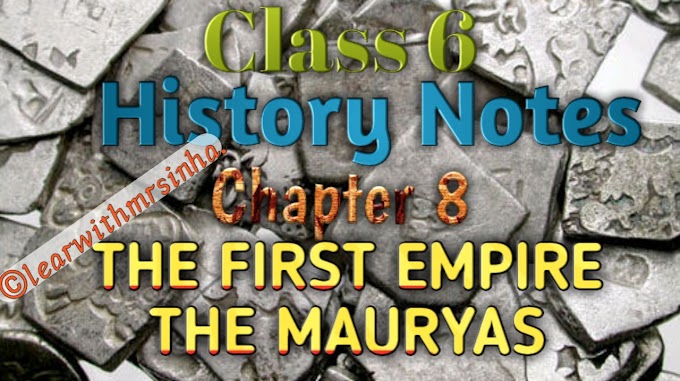The First Empire - The Mauryas
History Notes
Class
6
The Mauryas established the first ever empire (much larger than kingdom) in the history of India.
The Mauryas controlled more land than any ruler and dynasty.
Sources
The main source of information on the Maurya are two books :-
- Indika (Megasthenes). (About political, social and economical conditions)
- Arthashastra (Kautilya). (Deal with how to govern the Empire)
Others important sources - Rock, Pillar edict, inceptions, Coins.
MAURYAN EMPEROR
CHANDRAGUPTA MAURYA (321-297 BC)
First ruler Chandragupt Maurya. Overthrew the last Nanda ruler in 321 BC. Supported by minister Chanakya / Kautilya / Vishnugupta.Chandragupt first conquered Magadh. Next he defeated Seleucus Nicator a general of the the Greek king Alexander. Thereafter he tried to strengthen his control over the other part of the North India.BINDUSARA (297-273 BC)
Chandragupta was succeeded by his son bindusara. Defeated and added 16 kingdoms. Spread over whole of the Indian subcontinent except for Kalinga (Orissa) and a few Kingdom in south (friendly).EMPEROR ASHOKA (273-232 BC)
Ashoka was the famous Maurya king and one of the great ruler ever.HG Wells (British historian) amidst the tens of thousands of name of monarch that croud the column of history. The name of Ashoka shines and shine almost along like a star. Numerous Rock and pillars spread over India.
KALINGA WAR (261BC)
At that time Kalinga was not under Maurya control. Kalinga was important as it it controlled the land and sea route to South India and South East Asia. The war with Kalinga was a turning point of his life (Ashoka) . He realised the futility of fighting a war and vowed not fight any more war. He devoted the rest of his life to serve his peoples.Ashoka Dhamma
Prakrit word meaning Dharma (Sanskrit) which means religious duty. Ashoka gave up the policy of conquest through war (Dig Vijaya) and begin to follow a policy of of conquest through Dharma (Dhamma Vijaya). Spreading dhamma become Ashoka's goal of life.
History Notes Class 6
Principle of Dhamma
It was code of conduct and moral to be followed. Inspired by teaching of the Buddha. Through Dhamma he wants to instill the sirit of tolerance, co-existance, non-violence and respect for elders in the people. He ask peoples to :-
- Speak the Truth
- Respect other religion
- Obey their elders
- Follow the path of 'ahimsa'
- Practice charity towards poor
- Be kind to all including servents and slaves
- Leave together peacefully
Welfare Measures:-
Edict- 'All men are my childeren and just I desire for my children that thet should obtain welfare and happiness both in this world and the next, the same do I desire for all men.
He built good roads and planted trees on both sides constructed, resthouse, wells, hospitals. Want hapiness of his people.
Spread of Dhamma :-
Ashoka Led by personal example Issued edicts which contained the principal of dhamma minor edicts, describe the reform he carried out and the moral principal he encurraged. Most of his edicts were in Brahmini script, language - Prakrit, the languageof masses. Put that edicts in market places. Edicts have be found in India, Pakistan, Afganistan and Nepal.
He appointed officials called Dharma Mahamatras to spread dhamma.
Administration :-
Maurya administration can be divided into four divisions:-
- Central
- Provincial
- District and
- Village
The administration of the city of Patliputra was separate.Central :- The king was the supreme authority assisted by a council of ministers. They acted as the king's advisors.
Provincial :- The empire was divided into many provinces each headed by a prince. He ruled the province as a representative of the king and was assisted by many officers.
District :- Provinces were further divided into districts. The 'Pradeshta' was the head of the district. He was assisted by the 'yuktas' and the 'rajukas'.
They measure the land, collect taxes and maintained the law and Order
Village :- A number of villages made up a district villages have a head man choosen by villagers.
Science Notes Class 6
Patliputra :- (Capital of Empire ) Surrouded by wooden wal which had 64 gates and 570 towers and also a moat arount the city.
A committee of 30 members looked after the administration of the city. This committee was divided into six boards each comprising of five members. Each board looked after a special department, Such as :-
- Comfort and security of foreigners
- Registration of Birth and Death
- Industry
- Trade and commerce
- Inspection of manufactured goods
- Collection of taxes
Army :- Head foot soldiers, horses, elephants and chariots. Senapati was the head of the army spies (Men & Women)
Revenue :- Land revenue was the main source of income fixed between one fourth to one sixth. Revenue was also obtained by trade. Patliputra, Ujjain, Taxila (Takshila) and Broach were important inland trading centres. Oversea trade was carried out by on with Rome, Egypt, China and Srilanka. Othersource of income were forests, mines, custom duties, fines, and gift. Arthashastra also mention water tax.
Collected money sppent on maintaining the army, paying salaries to government officers, charity on public welfare activities such as building hospitals and roads.
The first census was done during the reign of the Maurya. It listed the people living in the empire, and their cast and occupation.
The third Buddhist Council is held at Patliputra at 250 BC by Pushyamitra Sunga in 185 BC.
*****







0 Comments